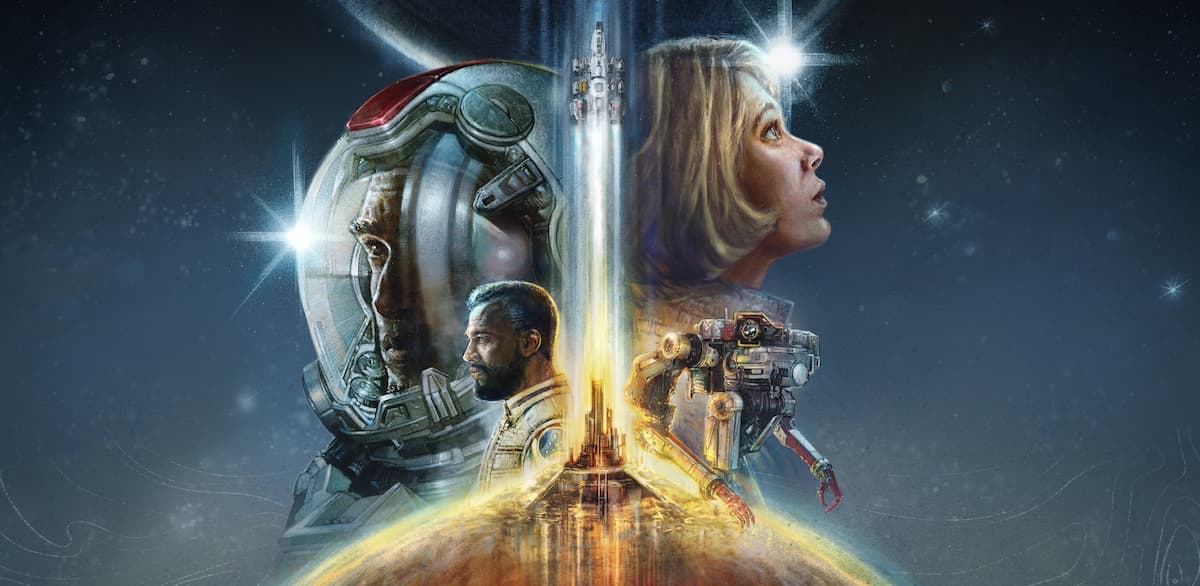Starfield on PC
There’s the call to adventure, the introduction of supernatural elements, and the congregation of like-minded individuals and mentors who help shape our protagonist into who they need to be to complete their mission. There are the challenges and temptations, an incredible and unbelievable revelation, the gradual realization of what must be done, the redemption arc, before everything comes full circle and our protagonist is right back where they started — just older and wiser.
In many ways, Starfield doesn’t really do anything new. It’s an open-world game with a tried and true story structure that’s been overused across all forms of media. Truly, the hero’s journey might be the most tiresome and overused narrative formula in TV and movies — and make no mistake, Starfield leans into it pretty hard. This should come as no surprise, considering that the hero’s journey serves as the backbone of most other Bethesda open-world games. And yet, despite Starfield’s unapologetic reuse of narrative tropes and open-world trappings, Bethesda has somehow managed to create something genuinely special here.
I guess I’ll start from the beginning.
The Call to Adventure
Starfield opens its story by placing you in the shoes of a regular space miner. During a mining job, you come across a mysterious artifact that gives you weird visions and hallucinations when you touch it. You’re then tasked with reporting to the Constellation, an organization that’s dedicated itself to collecting and studying these artifacts, all in the hope of one day finding out what it all means. This is the call to adventure and you, of course, are the chosen one. The artifact’s never reacted that way to anyone before, and it’s on you to collect the remaining artifacts and see where it leads you.
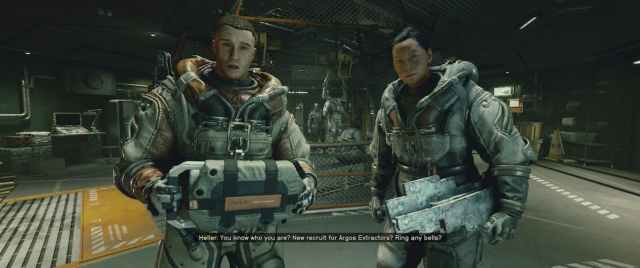
Right off the bat, I’ll say this much: the Constellation honestly aren’t particularly interesting. There are a couple of standouts, including Walter, the older entrepreneur who sometimes struggles in his strained relationship with his equally entrepreneurial wife, and Sam, a strapping young dad who travels around space with his daughter while trying to avoid his own rich father. The rest of the gang are kinda blah, often falling into predictable, one-dimensional trope-y arcs that just aren’t all that satisfying to follow.
I suppose that’s par for the course for most Bethesda games — as much as I loved Skyrim and still regard it as the best open-world RPG the studio’s ever made, I couldn’t name a single companion from that game even with a gun to my head.
The good news is that Starfield’s not gonna punish you for leaving these companions behind. One of the many traits you get to start with is Introvert, which gives you a slight stat boost for traveling alone. On the flip side, there’s also the Extrovert trait, which gives you a boost for traveling in a party.
I’d be remiss not to at least mention the Adoring Fan, who becomes available as a recruitable companion if you pick the Hero Worshipped trait. Described as your biggest fan, he shows up at random places in the game to shower you with gifts and compliments, which sounds great on paper, as long as you can put up with his incessant rambling. And I mean incessant.
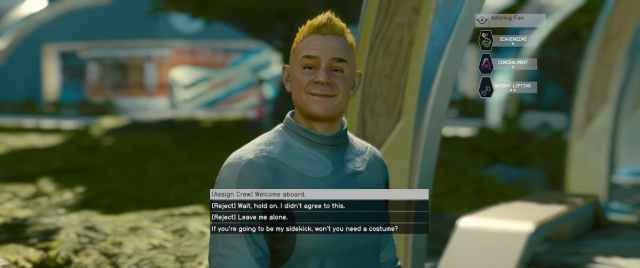
Each time you return to your ship, Adoring Fan is there to greet you with such gusto. He worships the ground you walk on, he dreams about reading a book about all your exploits one day, and every time you dock or land your ship, he tells you he’s never seen anyone dock or land a ship as perfectly as you just did. And look, you know what? I think we all could use a little more positive reinforcement in our lives in this day and age. Adoring Fan’s a good guy in my book. Recruit him.
So then Starfield’s all about traveling around outer space as you hunt down these artifacts, put them together, and try to make sense of what those visions mean. They’re all MacGuffins really, designed to give you something to chase as you get closer to the truth. If I sound a little down on Starfield’s main conceit, well, it’s because I was, at least at the beginning. Starfield doesn’t exactly have the strongest start, and initially I’d thought, “Well okay, the story’s kinda mid, but at least I’ll have fun just exploring space and doing quests and feeding my lizard brain as I go down the laundry list of things to do.”
That being said, while the game does take a while to get going (and I mean a while), the turning point in the story is well worth getting to. At one point in the game, Starfield’s narrative really begins to open up as you realize its scope and reach is much vaster than you think. Unless you’re planning on just rushing the main story like I did — which I do not recommend — it’s likely that a good portion of players may never reach that point. Still, this is a Bethesda game we’re talking about here. Even without a main story, there are still plenty of other things to chase.
The Temptations
In true “save the world” RPG fashion, the entire universe could be collapsing around you in video game land, but damn if you aren’t gonna take some time out of your busy schedule to check in on grandma’s ship for some food, or make a simple package delivery for a random courier ship you stumbled upon during your travels.
Just as you’d expect from your typical Bethesda game, Starfield has no shortage of side quests and faction missions for you to take on. After completing the prologue, you land on your first proper planet, Jemison, meet the Constellation, and off you go. All of a sudden, there are a hundred quests flying in your face as NPCs you pass by on the street start talking at you and telling you to do things. Before you know it, your quest log is a neverending laundry list of things to see and do, and the best part is that you never know what sorts of shenanigans you’ll find yourself caught up in as you chase them down.
There’s a staggering number of planets and systems to visit; not all of them are inhabitable of course, with only a handful of them featuring proper towns and cities for you to visit. But there are outposts, farms, and stations to find on the loneliest moons or in orbit. I have to say that trawling through outer space in Starfield often felt remarkably lonely. I suppose that’s to be expected when you have the whole of humanity spread out across the galaxy, but I couldn’t help but wish that the game world felt just a little more lived in.
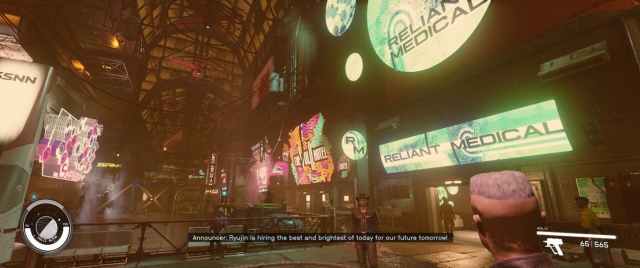
Because of that, it was always a welcome change of pace whenever I visited a proper city for the first time. From the old-timey western aesthetic of Akila City to the cyberpunk, neon-drenched grittiness of, well, Neon, Starfield is determined to hit every single sci-fi trope you could think of, while still keeping its story grounded in some semblance of realism. Billed as a “NASA-punk” sci-fi game, Starfield’s science-y elements feel refreshingly realistic, while also giving players the chance to live out their dreams of living in this game’s version of Night City as you uncover plots revolving around corrupt corporations and harvested organs.
The level of detail in Starfield is astounding, too. I’ll never cease to be amazed by how much effort Bethesda puts into the little things, like galactic space plushies and processed space food that feel appropriately clinical and sterile. 50 years from now, we could very well live in a world where we’re eating ramen out of a square packet labeled “Classic Flavor.” I’m not entirely sure I’m quite ready to leave the gastronomical delights of the 2020s behind, but Bethesda’s vision of the near future always feels uncanny and scarily realistic, which makes Starfield all the more immersive.
The Challenges
When you’re not running through cities talking to people, you’ll probably be spending time piloting your ship in space and taking down those hooligan Spacers. As far as combat goes, there really isn’t anything to write home about here. The gunplay itself is just about as basic as you’d expect, though it’s worth noting that Starfield’s gear system takes a page out of Diablo and Destiny’s book, and introduces a rarity system that you can engage with.
Rarer items tend to come with more mods and attachments that enhance that piece of gear, but make no mistake; Starfield also features a very in-depth modding system that lets you enhance your own basic gear with materials and resources you’ve picked up along the way. You could have three copies of the same gun, but decked out with completely different mods to suit different purposes — one for stealth, one for blasting in close quarters, and one for sniping from a slightly further distance.
While I was disappointed that Starfield seems to have done away with truly unique weapons, I found myself pleasantly surprised by how fun the modding system could be. It gives you a level of freedom and customization rarely found in other games of its ilk, and there’s nothing quite like the feeling of satisfaction that comes with finally getting that last part or resource you needed to mod the perfect pistol of your dreams.
Again, this doesn’t necessarily enhance the gunplay of Starfield; as a first-person shooter, it’s really nothing to write home about, and you can’t even take cover properly! But combat can feel pretty dynamic on occasion, especially if you lean hard into weapon modding and make use of the booster pack, which lets you jettison into the air to avoid enemy fire while getting an angle on your foes.
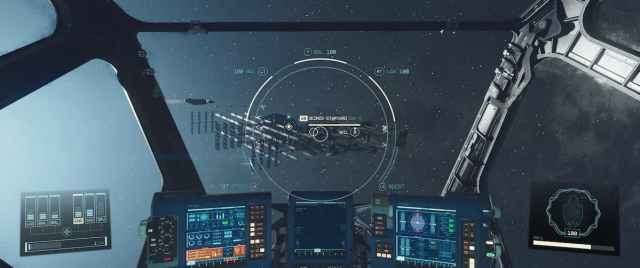
The ship combat might take some getting used to, though, especially in the early hours. Starfield starts you off with a fairly basic ship, and the dogfights usually all go the same way: lock-on to an enemy ship and start pelting it with your lasers and ballistics, and once the target lock is complete, finish them off with your missiles. The catch is that enemy ships can lock-on to you as well, and trying to dodge the target lock can be quite tricky.
I often felt like I didn’t have enough resources to keep my shields up while trying to take down enemy ships and dodge them at the same time, and it certainly doesn’t help that the game doesn’t do a great job of teaching you how to upgrade your ship. The ship upgrade UI feels awfully daunting at first, and you won’t be able to access the higher quality ship modules until you’ve put some skill points into the relevant sections in your skill tree. Again, it’s not very intuitive, and if there’s one thing that I absolutely did not enjoy about Starfield, it’s the poor tutorialization.
It’s not just the ships either; it’s the outpost-building, and the myriad status effects you can randomly contract while you’re out exploring, too. A lot of these little nuances you’ll learn to pick up on and deal with the more you play, but it bears mentioning that Starfield can actually be a bit of a frustrating experience when you’re first getting started.
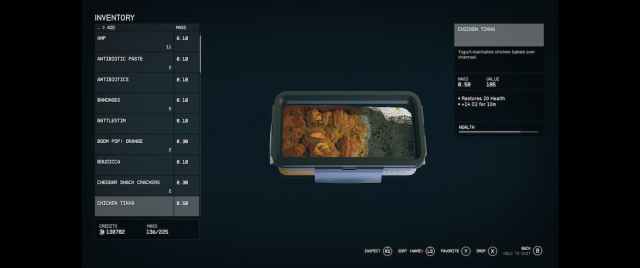
It’s a good thing, then, that Bethesda continues to be so damn good at what they do, and that is to create a world so immersive that you just can’t help but want to spend all your time in it. While it’s certainly not comparable to the likes of Baldur’s Gate 3, which is on a whole other level to be fair, Starfield offers you quite a few ways to play and approach its denizens. Whether you’ve chosen to be a stealthy thief who pickpockets or hacks their way through everything, or a smooth talker and master of persuasion, or just a callous brute who shoots first and asks questions later, there’s never a “wrong” way to play the game.
Even your methods of making money vary, as you can choose to be a notorious Spacer pirate who racks up bounties on multiple systems while killing your pursuers and selling their ships for gross amounts of Credits, or do things the honest way and be shrewd about hoarding valuables and selling them for the right price. Starfield excels as a hand-crafted role-playing experience that never lets go once it gets its hooks in you.
The Redemption Arc
Throughout my time with Starfield (40-something odd hours as I blitzed through the main story and only did the required side quests for leveling up), I never quite reached the same highs I did with 2011’s Skyrim. Yet, it is undeniable that this is Bethesda’s most impressive game to date, and perhaps even its most special.
Whereas Elder Scrolls delved deep into medieval fantasy and Fallout explored the possibility of living in a post-modern nuclear wasteland, Starfield goes further up the timeline and wonders how humanity would truly fare in outer space. The idea of living in the stars still feels far-fetched and incredibly far removed from where we are now, but somehow, Starfield manages to stand out as the most personal and realistic game of the bunch.
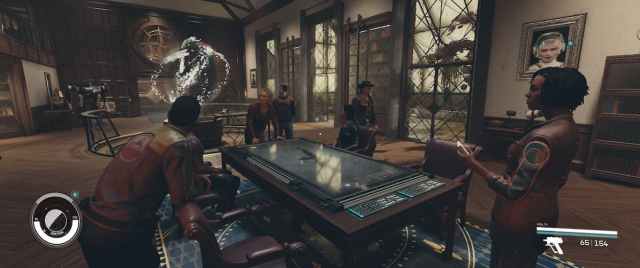
Of course, it’s the NASA-punk of it all. Instead of sleek, futuristic space armor a la Mass Effect, we’re still clamboring around in astronaut suits and big, clumsy helmets. Our ships still fall back on ‘archaic’ weapons like missiles and ballistics, and we’re all still working jobs we hate to lead a life in space we didn’t even ask for.
I suppose the hero’s journey story structure is popular for a reason: it has an appropriate amount of ups and downs that keeps the audience engaged, and watching our hero learn things and become stronger at the end never gets old. Starfield doesn’t necessarily break any new ground here, but perhaps it doesn’t need to.
In its second act, Starfield shows its cards as you finally realize what it’s all about, and that revelation is tremendous. You won’t be fighting dragons in this one, but Starfield doesn’t need any of that pizazz or showmanship to excel. The beauty of Starfield lies in its humanity, and how deeply it cares about the Earth we live on and what we’ll do to survive as a race. It’s a game about breaking through the final frontier, about appreciating what we have, about the lengths we’ll go to advance, and while it has its flaws and missteps, Starfield explores these themes with a sense of earnestness and authenticity that’s hard to find in most other titles. And maybe that’s all that matters.
Pros
Cons
The open-world feels quite lonely at times, and I wish it felt a bit more lived in.
The companions are mostly rather boring.
